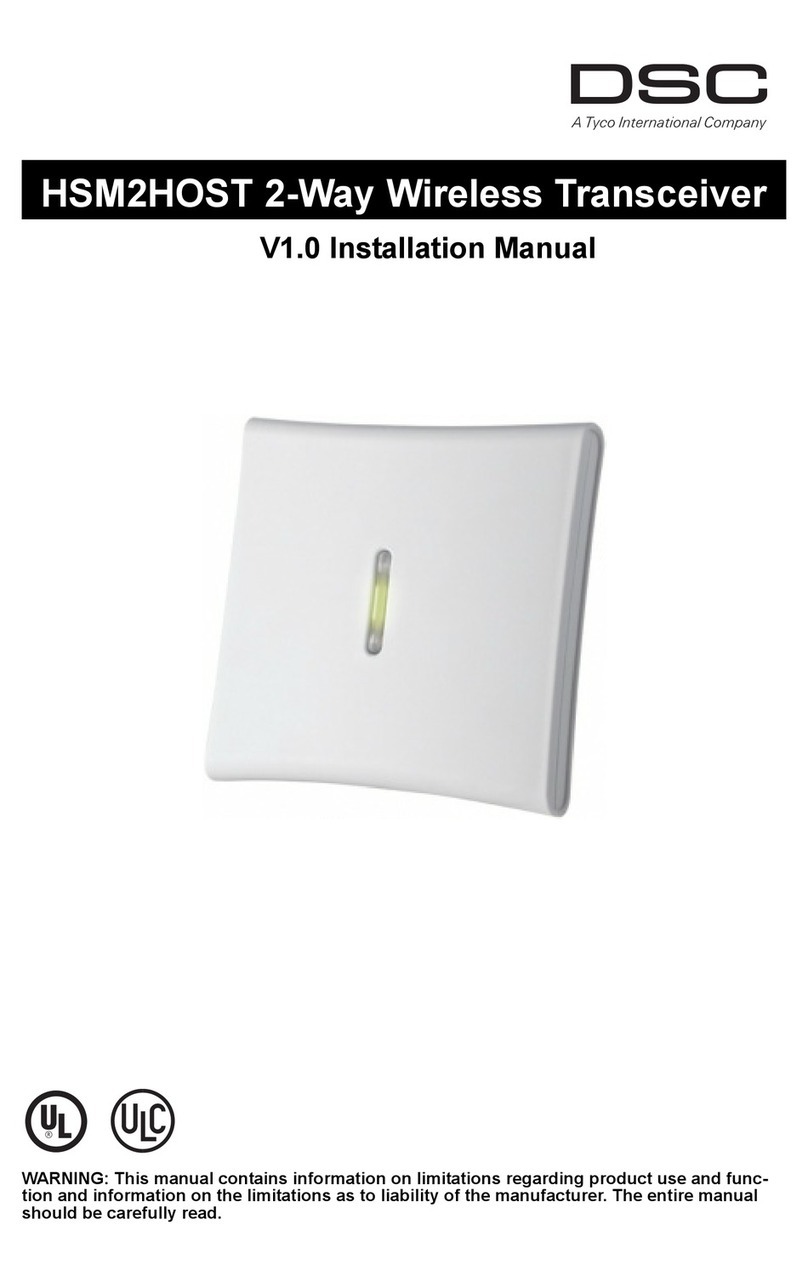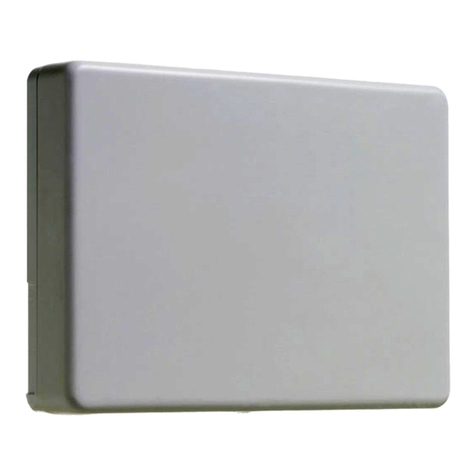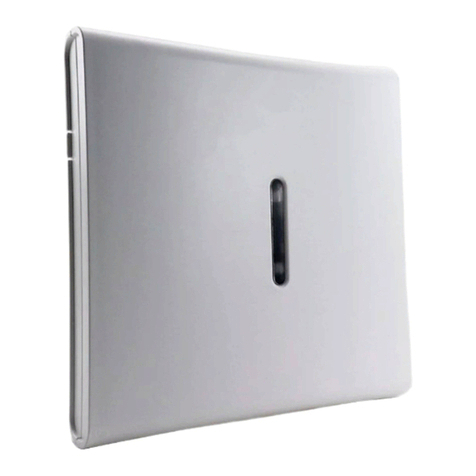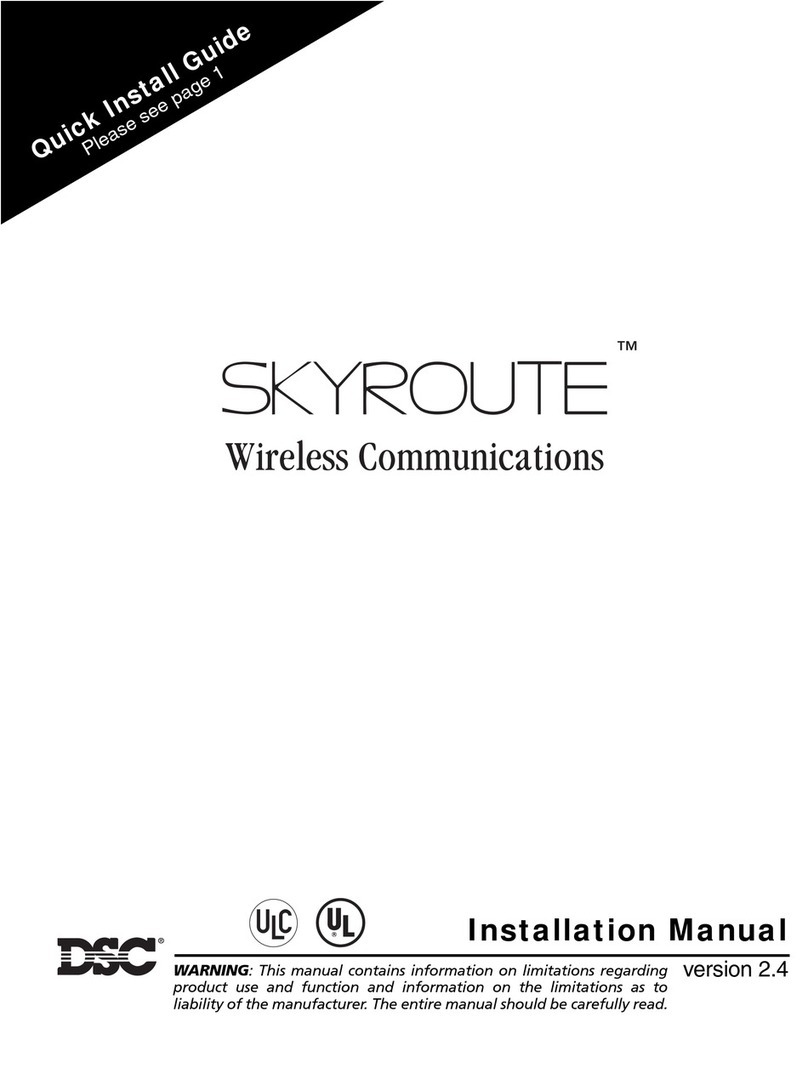
I
Specifications and Features
• Current Draw: 60 mA max.
• Voltage: Draws current from the PowerSeries Neo alarm control-
ler (7VDC to 14VDC)
• Frequency: 433MHz (HSM2HOST4), 868MHz (HSM2HOST8),
912-915MHz (HSM2HOST9UL)
• Zones - can receive signals from up to 128 wireless zones, plus
16 zones for wireless keypads. Also supports up to 32 wireless
keys
• Supervisory - programmable supervisory window
• Location:
• can be wired up to 1000 ft. / 230 m from the main panel
with 18 AWG wire
• connects to Corbus
• Compatibility: The HSM2HOST is used with PowerSeries Neo
alarm panels
• Operating temperature: 0°C to +49°C (32-122°F)
• Relative humidity: 93% non-condensing
• Separate, built-in wall and case tampers
NOTE: For UL/ULC Commercial Burglary and Residential Fire
applications, the supervisory window must be set to 4 hours. For Resi-
dential Burglary only applications, the supervisory window can be set
to 24 hours.
NOTE: Only models operating in the band 912-919 MHz are UL/
ULC listed where indicated. Only UL approved devices are to be used
with UL/ULC listed systems.
Compatible Wireless Devices
• Please refer to the instruction sheets of the following devices for
more information. On the chart below and throughout this docu-
ment, x in the model number represents the operating frequency
of the device as follows: 9 (912-919 MHz), 8 (868MHz), 4
(433MHz).
The HSM2HOSTx (x= 4/8/9) can receive signals from the following
devices:
Safety Instructions
• This equipment must be installed by Service Persons only (service person
is defined as a person having the appropriate technical training and expe-
rience necessary to be aware of hazards to which that person may be
exposed in performing a task and of measures to minimize the risks to
that person or other persons). It must be installed and used within an envi-
ronment that provides the pollution degree max 2, over voltages category
II, in non-hazardous, indoor locations only.
• The installer is responsible for instructing the system user in regards to
electrical safety precautions when using a system which includes this
equipment and also in regards to each of the following:
• Do not attempt to service this product. Opening or removing cov-
ers may expose the user to dangerous voltages or other risks.
• Any servicing shall be referred to service persons only.
• Use authorized accessories only with this equipment.
• Secure the receiver to the building structure before applying power to the
alarm controller.
Use adequate mounting means to secure the receiver to the building structure
(e.g., plastic/metal anchors and screws). Only UL/ULC listed devices can be
used in UL/ULC listed installations.
HSM2HOST9 is UL listed for Residential Fire and Residential Burglary appli-
cations in accordance with the following standards:
UL1610 Central-Station Burglar-Alarm Units
UL365 Police Station Connected Burglar Alarm Units and Systems
UL1023 Household Burglar-Alarm System Units
UL985 Household Fire Warning System Units
UL1637 Home Health Care Signaling Equipment
ULC-S304-06Signal Receiving Centre & Premise Burglar Alarm Control
Units
ULC-S559-04Equipment for Fire Signal Receiving Centers and Systems
ULC-S545-02 Residential Fire Warning System Control Units
ORD-C1023-1974 Household Burglar-Alarm System Units
Alarm Controllers
PowerSeries Neo alarm Controllers HS2128
HS2064
HS2032
HS2016
Modules
Wireless keypads HS2LCDWFx
HS2LCDWFPx
HS2LCDWFPVx
Wireless Devices
Wireless PG smoke detector PGx926UL
Wireless PG smoke and heat detector PGx916UL
Wireless PG CO detector PGx913UL
Wireless PG PIR motion detector PGx904(P)UL
Wireless PG PIR + camera motion
detector PGx934(P)UL
Wireless PG curtain motion detector PGx924UL
Wireless PG dual tech motion detec-
tor PGx984(P)
Wireless PG mirror motion detector PGx974(P)UL
Wireless PG outdoor motion detector PGx994UL
Wireless PG glass break detector PGx912
Wireless PG shock detector PGx935UL
Wireless PG flood detector PGx985UL
Wireless PG temperature detector
(indoor use) PGx905UL
Wireless PG key PGx939UL
Wireless PG key PGx929UL
Wireless PG panic key PGx938UL
Wireless PG 2-button key PGx949UL
Wireless PG indoor siren PGx901UL
Wireless PG outdoor siren PGx911UL
Wireless PG repeater PGx920UL
Wireless PG door/window contact PGx975UL
Wireless PG door/window contact w/
AUX PGx945UL



































